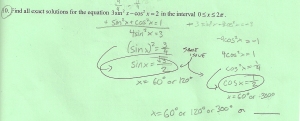Following is a snip from a 12.19.2011 post by James K. to the AP Calculus EDG . It was a response to a teacher’s frustration with her district increasing the number of students in her AP Calculus course and then evaluating her performance in part on the scores her students receive AP exam. Sorry for the length of the block quote, but it’s worth absorbing.
I have some separate thoughts about tests and teacher evaluation, which I’m hoping to carve out time for sometime soon, but I’m eager to develop the conversation around the following comments:
[citing another post] … I do get students with weaker and weaker math backgrounds. How weak? I have student who can’t evaluate sin(pi/3), and a student [who] can’t understand it’s the same to multiply a number by 1/6 and to divide it by 6. How did they pass precalculus? …. It feels nice to be able to say “I’m always willing to teach those willing to learn”, but how do you teach a class with huge gap in students’ capability? Teach fast, and you get lots of complaints. Teach slower, and the more capable students suffer. They (the more capable) are the ones that pay the price when we say “I’m always willing to …” [end internal citation]
What’s at the heart of this discussion is differentiating instruction: that is, developing and implementing activities (which can include lecture, as just one type of activity) which provide rich, effective learning for a wide variety of students. This requires acknowledging not only that students come to the class with diverse background knowledge and conceptual frames, but also that they are likely to leave the class with different knowledges and conceptual frames– in short, serving [intellectually] diverse students … means valuing significant growth at least as much as valuing specific pre-determined objectives.
This is, I believe, the greatest and most tragic failure of mathematics instruction over the past 4000 years: the teaching of mathematics almost invariably has been designed and implemented around an assumption that the cognitive development of mathematical ability is linear in nature, with the overwhelming result that math courses are substantially about distinguishing successful students (those who are able to reproduce a specific set of mathematical procedures and algorithms in novel contexts) from unsuccessful students (who are unable to do so) … as opposed to being about the development of better mathematical thinking in all of the students in the course.
That’s gotten a bit better, just in the past 100 years or so, but the culture is still overwhelmingly focused on determining who can “do the math” (and, implicitly, who cannot). I recognize that, particularly within the context of an AP course (where the desired outcomes of the course are richly and rigorously defined by an external examination), it’s hard to embrace the notion that it’s okay for students to come away from a lesson, a unit, and the entire course as a whole with different degrees of knowledge and understanding, and even with different ways of *approaching* their own understanding. That said, I think it’s the work that we ought to be doing: Teaching is about fostering growth. It’s certainly easier to do with a roughly uniform group– but I don’t let my students get away with ignoring the hard stuff, and I don’t let myself get away with it, either. That means we ought to be teaching at both (really, all) levels, simultaneously: give the weaker students what THEY need, while also giving the more capable students what THEY’RE ready for, all at once. Not easy, as I say, and especially hard to do through lecture (which is why that’s just one of the types of activity we should be using…)
I certainly haven’t achieved all I want to do with respect to differentiating instruction in my classes. I’ve also been part of numerous discussions like the one James advances above. His argument for reaching all students where thy are with what they need is, in my opinion, the great calling of all teachers.
What struck me as unique about James’ post was his focus on interpreting the outcome of an AP Course. I’ve never clearly thought about it in this way, but the standardization of a single international test for all students with only five possible outcomes (scores ranging 1 to 5) does drive one to believe that all students (if they would just try) will exit the course with the same curricular and comprehension results. I’ve worked for years (with varying success) to meet my students in their areas of need and have tried to promote their unique perspectives. I hope all of my students (no matter what their mathematical background) say my classes push them to think in new ways and encourage them to apply what they have learned in ways unique to their own perspectives. What I hadn’t fully considered was the pervasive way external tests can leverage teachers away from that ideal.
So, I recommit myself to
the notion that it’s okay for students to come away from a lesson, a unit, and the entire course as a whole with different degrees of knowledge and understanding, and even with different ways of *approaching* their own understanding,
especially when teaching courses with external final assessments.





